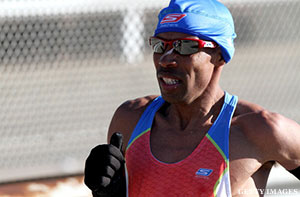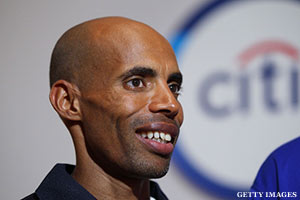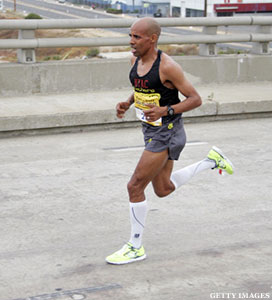By Tom Rotunno
CNBC.com
Sometimes the sports marketing universe aligns in perfect ways. For Skechers and Meb Keflezighi, August 2011 was one of those times.
Skechers, a company known for its lifestyle footwear brand, was launching its first performance running shoe and needed a boost of credibility to capture the attention of the running marketplace.
Keflezighi, a legend in the running community, was an aging athlete in need of a sponsor. The pair announced their partnership in August 2011 and one year later, Keflezighi will be wearing Skechers when he competes as the top American runner in the 2012 London Olympics men's marathon.
 |
| Slideshow: Part-Time Athletes |
While Keflezighi and Skechers bask in the Olympic moment, their union wasn't without risk. In early 2011, Keflezighi, a silver medallist in the 2004 Olympic Games, was cut by his longtime sponsor, Nike, just two years removed from winning the New York City marathon.
After suffering a potentially career-ending injury during the 2008 Olympic Trials, many thought the runner's best days might be behind him. Despite his past success, Keflezighi was reaching an age when the rigors of competitive running typically catch up to an athlete.
But while the level of his future performance was uncertain, his status as an ambassador of the running community was unquestioned.

For his part, Keflezighi would be trusting his most essential piece of equipment to a brand more famous for leisure than performance. Skechers had developed a well-earned reputation for being masters at spotting retail fads, exploiting them and moving on to the next big thing.
Now it was entering another booming area: The minimalist/lightweight running shoe market. While accounting for just $500 million of the overall $7 billion running shoe market, the minimalist trend is one of the hottest in sports retail. So while Keflezighi wanted a sponsor, he also wanted to alleviate his concerns.
"There are always risks when you make changes, you have to do your due diligence," Keflezighi told CNBC. "After training in the Skechers running shoes, I met with the company executives and the product team. I really got excited about Skechers' future in running and if I didn't feel I could train with Skechers GOrun and win races and run personal bests, I would not have signed with (them)."
In his first race in the Skechers GOrun shoe, Keflezighi ran the New York City marathon in 2:09:13, a personal best. A few months later, his second race in the brand, he would win the U.S. Olympic Trials with another personal best (2:09:08). Nearly one year after losing his longtime sponsor, the aging icon was on his way to the Olympics and bringing his upstart performance shoe maker along for the run.
"For Skechers, really only being in the running business for 15-18 months, it's monumental to say here is a guy that's going to be in the Olympics wearing our brand," says Rick Higgins, Vice-President of Skechers Performance Division.

While Keflezighi's winning the Olympic trials grabbed headlines, putting his name behind the product got running retailers and consumers to take notice even before he first hit the roads in them.
“The day we signed Meb the core running community picked up their head and it was almost as if we got instant credibility," Higgins continued. "It opened up a lot of doors for us and some different distribution channels. They actually would make appointments with because they knew Meb was a guy that wouldn’t get behind something that he wasn't a believer in."
Getting into core running stores is a key step for the brand says Matt Powell, an analyst for SportsOneSource, a sports market retail tracking firm that monitors sales in sporting goods stores.
"As a fashion casual brand, the typical sales outlet are the family shoe outlets. But the family stores don’t have the service level that a typical running store has," says Powell. "They're not well versed in the technical aspects of the shoes they sell."
While the casual shopping outlets may not be up to speed on the technical aspects of Skechers GOrun shoe, the running community has taken notice. The April 2012 issue of Competitor magazine named GOrun the "Editor's Pick for Most Innovative New Running Shoe" while the May/June 2012 issue of Women's Running declared Skechers GOrun a "Most Innovative Award Winner."
Skechers' Higgins says the early positive reviews have been crucial to gaining acceptance as a legitimate player in the performance shoe market.

"There really was a wall up against us," says Higgins. "The core runner is very loyal to their brands but we've just been chipping away."
There is still a lot of work to be done, with Skechers accounting for one percent of overall running shoe market according to SportsOneSource’s Powell. But no matter the result in London, Keflezighi says it's important to know his sponsor is invested in him off the course too.
Keflezighi feels he's not just carrying the torch for Skechers, but for the entire running community.
"I have made it a point to be a leader in the resurgence of American distance running. I work very hard every single day to get the best out of myself," he says. "It means a lot to me that Skechers not only appreciates what I have done in the sport, but also believes that I can still do great things."
When he toes the line for the start of the 2012 men's Olympic marathon, it will be vindication for Keflezighi from those who thought he had nothing left in the tank. As for what it means for the Skechers brand, he isn’t saying, preferring to let his performance in the last year do the talking for him.
"I let my running speak for itself," Keflezighi told CNBC. "I think (those) facts give more credibility to Skechers than anything I can say."
-- Follow Tom Rotunno on Twitter @tomrotunno.




